
views
Eating to Gain Weight
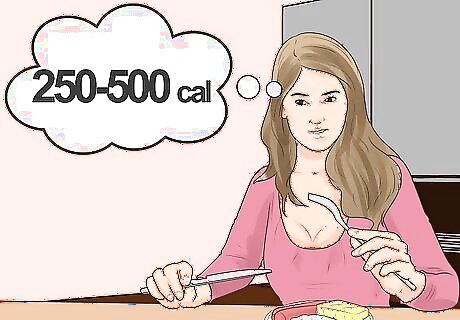
Increase your daily calories. If you have a 2-month time period to gain weight, you'll need to increase your calories by about 250 or 500 calories daily. Small caloric increases result in healthy and gradual weight gain. In general, you should aim to gain about half a pound to one pound per week. Increasing your total daily intake by more than that can cause rapid weight gain, which isn't healthy. Use a food journaling app or online diary to find out how many calories you currently eat. Add 250-500 calories to that number to figure out what daily caloric intake you should aim for. For example, if you currently eat 1600 calories daily, shoot for 1850-2100 calories daily to gain weight.
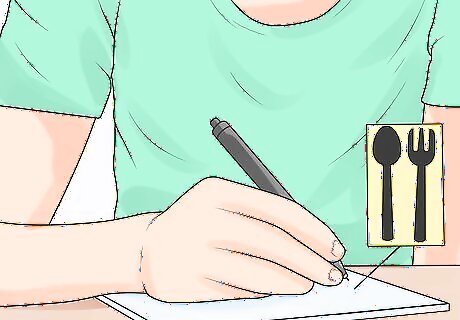
Write up a meal plan. Whenever you're trying a new diet plan, it may be helpful to write up a meal plan for your new eating pattern. Meal plans are somewhat like a blueprint of all your meals and snacks for an entire week. This can give you the plans to stay on track with the right types and amounts of foods for the week. Write up a list of all the meals, snacks, and beverages you'll be eating over the course of the week. It may also be helpful to write up the corresponding grocery list as well. This may make grocery shopping easier too.
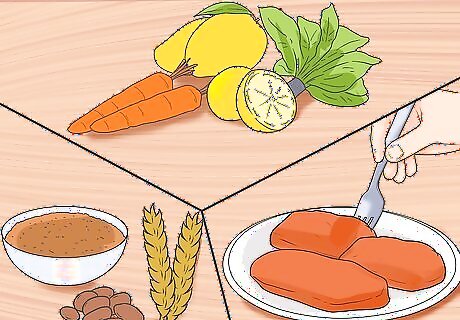
Eat balanced meals. Regardless of whether or not you're trying to lose or gain weight, it's essential to eat balanced meals. A balanced diet means eating a wide variety of foods from each food group most days and over the course of a week. Eat the following food groups: Protein foods. These include eggs, dairy, red meat, seafood, poultry, and legumes. Include a 3-4 oz serving of protein-based foods at each meal and snack. Fruits and vegetables. Aim to have 1-2 servings of fruit daily (about 1 small piece or 1/2 cup chopped) and 4-6 servings of vegetables daily (1 cup or 2 cups salad greens). Grains. Try to go for whole grains when you can (like quinoa, brown rice, or 100% whole-wheat bread). Servings are about 1 oz or 1/2 cup of cooked grains.
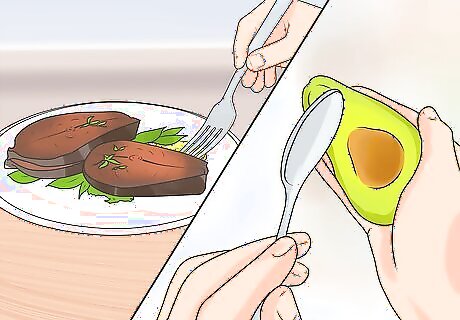
Add more calories to your meals. You can increase the total calories at your meal by about 100-200 calories per meal to result in an extra 300-500 calories daily. Also choose higher-calorie foods. Some foods are naturally higher in calories and healthy fats and are a nutritious way to bulk up the calories in your day. Using both lean and moderate fat protein will help add more calories to each meal. Choose foods like whole eggs, full-fat dairy products, dark meat poultry, or beef that's moderately high in fat. If you're a fan of avocado, stock up on this higher calorie and nutritious food. Add it to salads, scrambled eggs, or make guacamole with them. Also choose fatty fish and seafood like salmon, tuna, sardines, or mackerel. They're higher in calories and heart-healthy fats. For example, instead of turkey meatloaf with lean meat, use the dark ground turkey meat or use real, whole eggs instead of egg substitutes. Switch to full-fat yogurt, cheese, and 2% milk instead of the low-fat or fat-free options. If you can, eating slightly larger portions can also help you get in extra calories. However, if this is difficult or uncomfortable, continue with choosing higher-calorie foods.

Use higher-fat condiments and sauces. Changing what you cook your foods in or what you use as condiments is another way to add in extra calories. Cook foods in butter or olive oil instead of no-calorie cooking sprays. You can also drizzle extra olive oil over vegetables, grains or proteins that you cook. Top your foods with higher calorie condiments like full-fat sour cream or full fat shredded cheese. If you're making casseroles or mixed dishes, use full-fat items as well. For example, use regular whole milk or cream in mashed potatoes instead of skim milk.
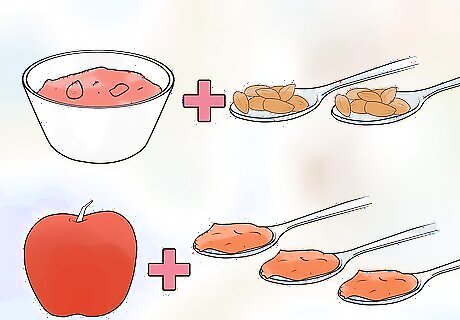
Add in an extra snack. Including an extra snack or small meal is another way to get in an extra 250-500 calories each day. Try to include a source of protein, fruit or vegetable. This helps make the snack balanced and nutritious. Examples of snacks that are 250 calories or more include: a small apple with 2-3 tbsp of peanut butter, 1/2 cup of trail mix or 1 individual full fat greek yogurt with 2 tbsp of nuts. If you do not currently snack between meals, adding in 1-2 snacks daily may be all you need to do to gain weight gradually. If you already snack during the day, try to make your snacks more planned and find the time for an additional snack in between or after meals. Adding a snack before bed may help you gain weight.
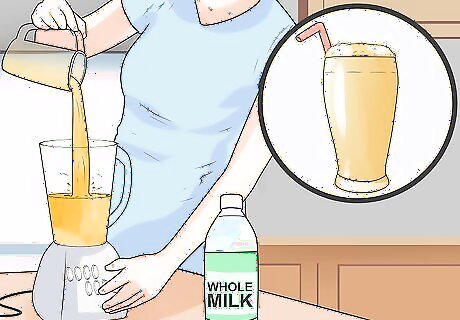
Increase the calories of your beverages. An easy way to get in extra calories each day is with higher-calorie beverages. Drinking higher calories fluids may be an easy way to get more calories in overall as liquids do not fill you up as much as larger portions or heavier, higher-calorie foods. Choose items like 2% or whole milk, 100% juice, or use full-fat creamer in your coffee. You may also want to make smoothies to increase liquid calories. You can add milk, full-fat yogurt, fruit, or nut butters to make a higher calorie, yet nutritious smoothie. Although the occasionally sweetened or sugary beverage is OK, do not make these the main source of your extra liquid calories. Items like regular soda, fruit juice cocktails, alcohol, or sports drinks are high in sugar and provide little to no nutritional benefit.
Incorporating Exercise

Continue with aerobic exercise. Although aerobic exercise burns calories and can cause weight loss, it's still an important part of a healthy lifestyle. Aerobic exercise has many health benefits including improved sleep, improved moods and better control of high blood pressure or diabetes. It's typically recommended to do about 2.5 hours of cardio activities each week. Stick to low to moderate intensity activities to help support your weight gain. Try: walking or a slow jog, a leisurely bike ride, hiking or swimming.

Include regular strength training. When you're gaining weight, strength training can help you gain muscle mass instead of all fat mass. Regular resistance training or strength training can help build lean muscle mass. This is typically more ideal than gaining all fat mass. Do about 2-3 days of lightweight strength training. You may want to try yoga, pilates, or use light free weights.

Increase your baseline activities. If you're having difficulty gaining or maintaining your weight, focus on increasing your baseline activities instead of cardio and strength training. Baseline or lifestyle activities are the exercises that you already do in your normal daily routine. For example: walking to and from your car or doing household chores. These types of activities do not typically burn many calories or cause weight loss, but do show to have some health benefits. Increase your baseline activity by taking more steps in your day or walking more frequently, taking the stairs rather than the elevator or parking farther away.
Tracking Your Weight Gain Progress
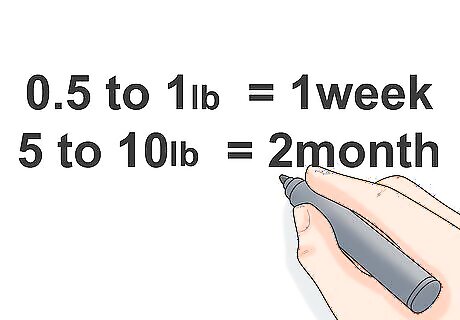
Set reasonable goals. With weight loss or weight gain, it's helpful to set reasonable and realistic goals. With weight gain, you'll want to aim for a gain of about a half to one pound each week. That means in a two-month time span you could gain anywhere from 5-10 pounds. You may also want to set smaller, more frequent goals along the way to let you know how well you're progressing is going. For example, if you want to gain 1 pound per week, but you're only gaining a 1/2 pound per week, you can readjust your meal plan and calorie goal to help you increase your weight gain. If you need to gain more weight than that you'll most likely need to readjust your goal timeline to allow for further weight gain.

Start a food journal. Food journals will be very helpful when you're trying to gain weight. They will serve as a guide when planning your goals and if you need to make any changes. Track all the foods you eat each day. Include all meals, snacks and beverages in one day. Try to be as accurate as you can. You may need to use a food scale or measuring cups to help keep you on track. Also keep track of your total caloric intake each day. This will help you if you need to make changes to your calorie level.
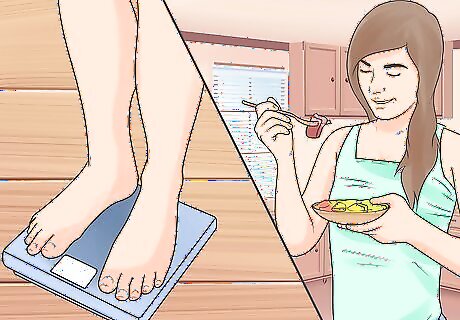
Track your weight. Keeping track of how much weight you've gained will be incredibly important. If you don't keep track it'll be difficult to tell how much you've gained and if you've met your goal. Get on the scale about 1-2 times per week. Weight gain happens more slowly than weight loss, so more frequent weighing will not be useful. For the most accurate weight, try to get on the scale the same day of the week and at the same time. Keep track of your weight and progress in your food journal.




















Comments
0 comment